The ASUS ZenPad S (Z580CA) Review
by Brandon Chester on August 31, 2015 8:00 AM ESTDisplay: Stock Settings
I often say that a smartphone is just a display you interact with, which makes the need for a high quality screen paramount. This is even more true for tablets, which are quite literally large touchscreen displays that the user interacts with. With tablet displays having peaked in terms of resolution for the time being, manufacturers are now turning their attention toward color accuracy. Flagship devices like Samsung's Galaxy Tab S tablets and Apple's full sized iPads feature displays with an exceptional level of color accuracy, while smaller or less expensive tablets are more hit-and-miss.
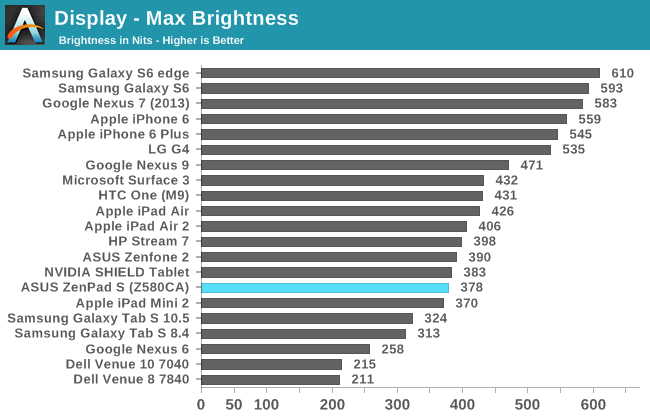

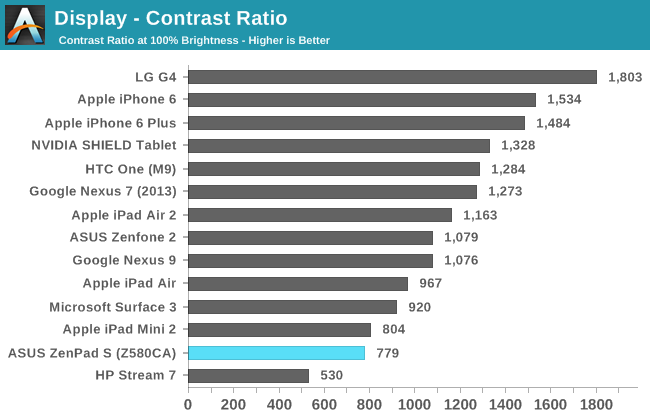
Unsurprisingly, the ZenPad's display is very similar to that of the iPad Mini 2 as far as brightness, black level, and contrast are concerned. While Apple has decided to round 7.85" to 7.9", and ASUS has decided to round to 8.0", I'm fairly confident both devices are using the same LCD technology with different backlight arrays. It should be noted that while the contrast ratio is similar in our measurements, when there is ambient light there will be a much more significant drop in contrast on the iPad Mini 2 due to its unlaminated display.
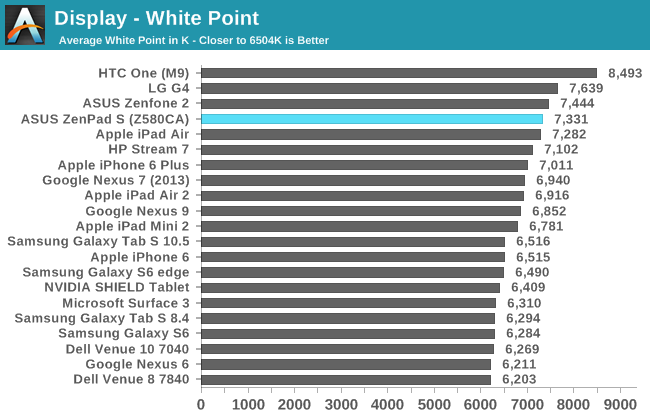
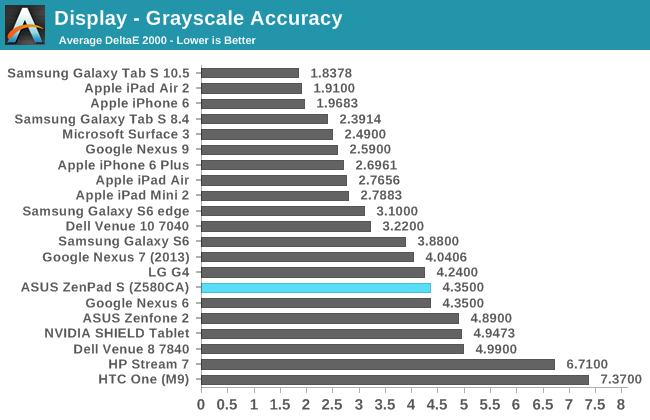
Even if two devices use the same display panel, the color characteristics of each can vary significantly depending on the level of calibration, as well as the spectral range of the LED backlight used. Apple’s iPad Mini 2 achieves a level of greyscale accuracy where errors can only be seen in static content, and is good enough for editing photos and videos without concerns about the accuracy of the images. The ZenPad S doesn’t do as well, with a significant blue shift to most shades of grey. This is also reflected in the display’s high average white point of 7331K. While the ZenPad S doesn’t cost as much as an iPad Air 2 or a Galaxy Tab S2, the Z580CA’s price of $299 is exactly the same as the iPad Mini 2. With that in mind, it’s concerning to see such a gap between the greyscale performance of the ZenPad S and the iPad Mini 2.
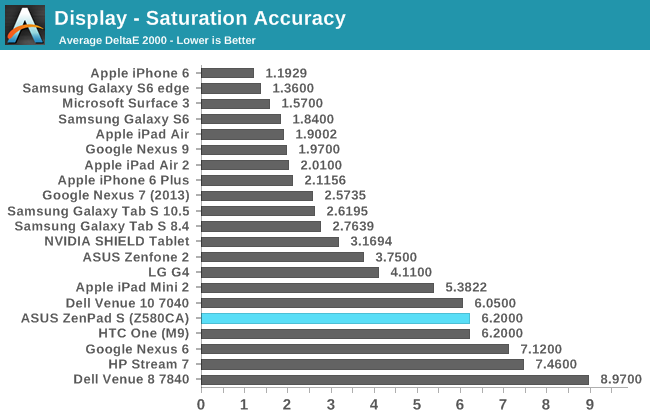
Saturation accuracy on the ZenPad S is much lower than what could be achieved with more attention paid to the display’s calibration. With a DeltaE average of 6.2, the ZenPad S is actually less accurate with rendering primary and secondary colors than the iPad Mini 2, despite the latter having a backlight array that only allows for narrow coverage of the blue and red parts of the sRGB gamut. The spectral range of the LEDs in the ZenPad S almost covers the entire sRGB gamut, but the panel undershoots significantly with reds, overshoots with blue beyond 60% saturation, and has various levels of inaccuracy with yellow, cyan, and most of all, magenta. I was really excited to see that the ZenPad S doesn’t suffer from the narrow gamut of the iPad Mini 2, but I was let down when I realized that the accuracy of primary and secondary colors was actually worse than the iPad due to inadequate calibration.
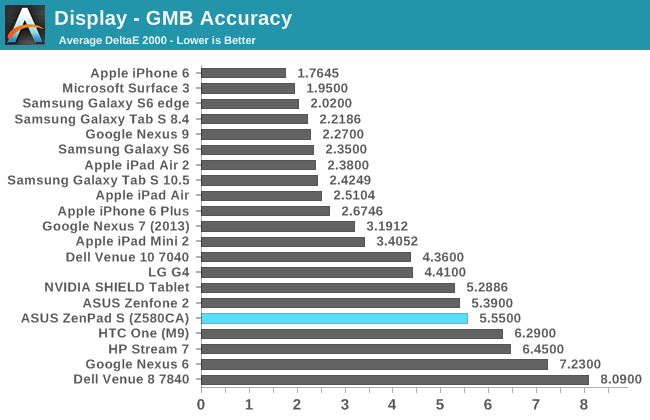
Accurately reproducing color mixtures requires a reasonably accurate gamma, RGB balance for grey shades, and accurate saturations. Gamma on the ZenPad S is reasonably accurate for a mobile device, but the way the display tends toward blue coupled with the inaccurate saturations results in inaccurate color mixtures as well. The ZenPad’s average DeltaE of 5.55 doesn’t compare favorably with the iPad Mini 2’s DeltaE of 3.4 which is imperfect but still fairly accurate. The reason that the iPad Mini 2 ends up being more accurate is because while it cannot be accurate outside its native gamut, within the section of sRGB that it does cover it is very accurate.
As far as the default display configuration of the ZenPad S goes, I’m not exactly thrilled. While it does have a wider gamut than the iPad Mini 3, it ends up being less accurate in every respect due to issues with rendering primary and secondary colors, and a blue shift in the greyscale. Surprisingly, the ZenPad S having a fully laminated display has done nothing to reduce black levels and increase contrast ratio when compared to the non-laminated iPad Mini 2 display, which is an additional disappointment. However, ASUS does provide a few settings to tweak the display, and so hope is not lost.


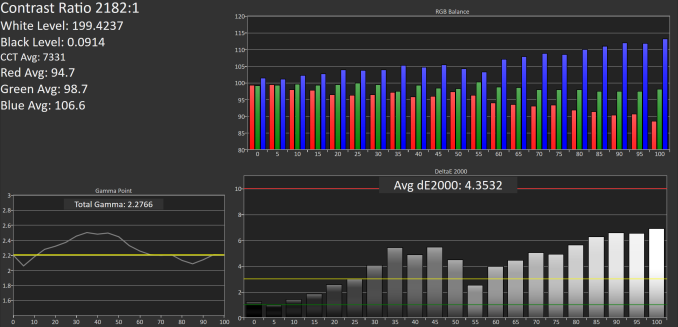

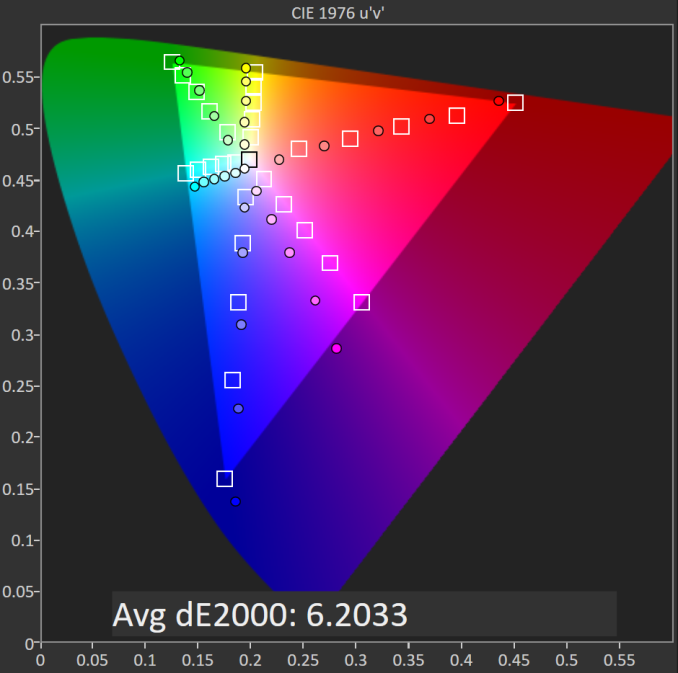









114 Comments
View All Comments
Brandon Chester - Monday, August 31, 2015 - link
Thanks for the feedback. I actually did have a white light box at one point which was used in older reviews, but it fell apart and I haven't been able to make another one yet.MonkeyPaw - Monday, August 31, 2015 - link
Thanks for responding. I've seen it on some other AT reviews as well. We tech nerds like some good product shots to drool over! :pSniperWulf - Monday, August 31, 2015 - link
I bought this tablet at launch. I must say, it is absolutely the best that I've ever owned! Easily beats out all the others, and that list isn't short. Both Nexus 7's, a Nexus 10, 2nd Gen Transformer, Tab S 10.1, iPad 2, iPad 3 and that raggedy ass Shield Tablet. Sure it doesn't have the biggest and baddest of GPUs but it punches above its weight class. The Atom is a strong performer and the storage is awesome!My wife has the 580C and she loves it for what she does.
My only caveat is that you can't disable all of those duplicate Asus apps that you don't really need.
linster - Monday, August 31, 2015 - link
I'm actually enjoying this tablet as well. I've owned the original iPad, iPad 3, Nexus 7 2013, and the Galaxy Tab S 8.4. I do notice that text on some websites just look very light, and could use a bold function. I'm not sure if that's the nature of the site, or the image "improvement" that Asus is doing. I've been thinking maybe it's just my eyes getting weaker as I get older. Browsing is great though, so that's reflected in this review.Sunburn74 - Monday, August 31, 2015 - link
What is the stylus like in real use?MrSavage - Monday, August 31, 2015 - link
At this point, only a couple of Taiwanese websites have reviews/hands-on time with the Z Stylus. If you can translate those sites, it might help. Decent photos though and give a decent idea, but not exactly ideal.SniperWulf - Monday, August 31, 2015 - link
Can't say. Haven't found it for sale anywhere yet. Although I haven't really been looking.deppman - Friday, September 4, 2015 - link
That "Raggedy ass" Shield tablet, released 14 months ago at at $199, destroys the performance on this tablet in almost all aspects. It even has better cameras and a second-generation touch-sensitive stylus. I use one every day (the $299 LTE/32GB model) and can't see any benefit to this tablet in comparison.Jerch - Monday, August 31, 2015 - link
Am I in the minority for holding on to my Nexus 7 (2013) for this long because nothing has yet to surpass it in the crucial areas of battery life, display brightness, and price? It's the perfect beach tablet. Crank that brightness all the way up, and you're good to go for several hours, plus it's so cheap and abused by this point that I don't worry about sand and moisture. I've started to feel it getting slower and choppier, though, so I'd love to upgrade to a [hypothetical] new version!MrSavage - Monday, August 31, 2015 - link
Give me a refresh with phone support and stylus support and I'm 100% happy with that too. I guess that would kill off some of the cheap pricing, but I'd be happy to pay.